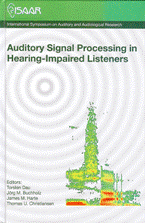Hearing loss can muddy the waters of otologic disease detection
Abstract
A few decades ago, there was a strong movement to develop non-invasive physiological measures correlated to the presence of hearing impairment. For simplicity, let us define hearing impairment as difficulty in processing acoustic information. The impetus was identification of hearing loss in infants and children in whom behavioral measures were dif cult to interpret. In the ensuing years, reliable physiological measures correlated to hearing loss of cochlear origin have been developed. We now have physiological measures to screen for hearing loss in infants and children. Currently, we are focused on the clinical refinement of these measures to detect and quantify the degree of hearing impairment more quickly, more easily and with greater accuracy. While a major focus was the detection of hearing impairment in infants and young children, there was parallel development of physiological measures to aid in the diagnosis of hearing problems in adults. However, the focus was not to detect the presence of hearing loss because reliable behavioral measures were available. Rather, the focus was on determining either the presence or the underlying cause of the hearing problem including any neurological problem affecting the auditory central nervous system. Thus, the question is not whether there is hearing impairment, but rather, is the impairment in the cochlea, auditory nerve, or in the higher nervous system? Peripheral hearing impairment (i.e., cochlear insult) is a common manifestation of otologic diseases. However, often in adults, the clinical goal is not simply to establish the presence of this peripheral hearing impairment but to detect objectively the presence of a specific underlying otologic disease. In the search for physiological correlates of a specific otologic disease, we often find that the simple presence of hearing loss confounds the correlated physiological measures and dilutes their diagnostic value. Two obvious solutions to this problem are: (1) determine ways to compensate for the confounding effect of the hearing impairment on the physiological measure, or (2) develop physiological measures that are essentially unaffected by the hearing loss. This paper provides examples of these confounds and solutions when using auditory brainstem responses (ABRs) measures. ABRs have been used extensively over the years to assess hearing impairment. For many clinicians, there was high expectation for what ABRs could tell us about auditory function. From this author’s viewpoint, due to the lack of understanding of what ABRs represent, the over-interpretation of these measures, and the inappropriate use has led to disappointment as a reliable and accurate measure for assessing auditory function. However, its proper use, interpretation, and implementation can provide valuable information about the hearing impairment.
References
Don, M. and Kwong, B. (2002). “Auditory Brainstem Response: Differential Diagnosis,” Handbook of Clinical Audiology, Fifth Edition, Ed. Jack Katz. Lippincott Williams & Wilkins Publishing, Media, Pennsylvania, 274-297.
Don, M., Ponton, C. W., Eggermont, J. J., and Masuda, A. (1994). “Auditory brain- stem response (ABR) peak amplitude variability reflects individual differences in cochlear response times,” J Acoust Soc Am., 96, 3476-3491.
Don, M., Masuda, A., Nelson, R. A., and Brackmann, D. E. (1997). “Successful detection of small acoustic tumors using the stacked derived-band auditory brain-stem response amplitude,” Amer J Otol. 18, 608-621.
Don, M., Kwong, B., Tanaka, C., Brackmann, D. E., and Nelson, R. A. (2005a). “The Stacked ABR: A sensitive and specific screening tool for detecting small acoustic tumors,” Audiol Neurotol. 10, 274-290.
Don, M., Kwong, B., and Tanaka, C. (2005b). “A diagnostic test for Meniere’s disease and cochlear hydrops: Impaired high-pass noise masking of ABRs,” Otol Neurotol. 26:711-722.
Eggermont, J. J., Don, M., and Brackmann, D. E. (1980). “Electrocochleography and auditory brainstem electric responses in patients with pontine angle tumors,” Ann ORL. 89: Suppl 75.
Parker, D. J., and Thornton, A. R. D. (1978). “Frequency-specific components of the cochlear nerve and brain stem evoked responses of the human auditory,” Scand. Audiol. 7, 53-60.
Selters, W.A. and Brackmann, D.E. (1977). “Acoustic tumor detection with brain stem electric response audiometry,” Arch. Otolaryngol. 103:181-187.
Teas, D. C., Eldredge, D. H., and Davis, H. (1962). “Cochlear responses to acoustic transients. An interpretation of whole-nerve action potentials.” J. Acoust. Soc. Am. 34,1438-1489
Additional Files
Published
How to Cite
Issue
Section
License
Authors who publish with this journal agree to the following terms:
a. Authors retain copyright* and grant the journal right of first publication with the work simultaneously licensed under a Creative Commons Attribution License that allows others to share the work with an acknowledgement of the work's authorship and initial publication in this journal.
b. Authors are able to enter into separate, additional contractual arrangements for the non-exclusive distribution of the journal's published version of the work (e.g., post it to an institutional repository or publish it in a book), with an acknowledgement of its initial publication in this journal.
c. Authors are permitted and encouraged to post their work online (e.g., in institutional repositories or on their website) prior to and during the submission process, as it can lead to productive exchanges, as well as earlier and greater citation of published work (See The Effect of Open Access).
*From the 2017 issue onward. The Danavox Jubilee Foundation owns the copyright of all articles published in the 1969-2015 issues. However, authors are still allowed to share the work with an acknowledgement of the work's authorship and initial publication in this journal.


